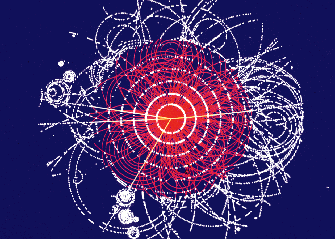
With construction work for CERN’s LHC and its big detectors under way (and en route to the scheduled commencement of the programme in 2005) a workshop, Standard Model Physics (and more) at the LHC, was held at CERN. The first plenary meeting took place on 25-26 May 1999. The second, and final, meeting was held on 14-15 October 1999.
The goal of the workshop, not evident from its subdued title, was to promote physics studies at the LHC beyond the main focus of the LHC physics programme. The physics community is very much aware of the need to ensure that physics remains lively during the long years of LHC machine and detector construction. Exploring additional possibilities – beyond the spearhead search for the long-awaited Higgs particle and other new objects, especially supersymmetric ones – were, therefore, very much to the fore.
To attack specific physics objectives, working groups were set up on QCD, electroweak interactions, top quark physics, and beauty physics. Subgroups were formed on the production of B-particles and on the decays of B-particles. In each group, theorists, together with experimentalists from ATLAS, CMS and LHCb, acted as convenors. Heavy-ion physics held its own workshop.
The meetings attracted many participants. Included were a substantial number of theorists from outside of CERN. The organizers were happy to see distinguished visitors from the US. Some of the visitors took an active role as convenors and many presented talks. The participation of experimentalists, on the other hand, reflected that most of them were either busy making LHC detectors or were still working on current experiments. Overall, the experience was positive, and similar meetings will take place in the future. The plenary meeting in October presented the preliminary results of the workshop. A more complete and final version will soon be published.
In one year the LHC should produce between 10 and 100 million top quarks and antiquarks, so the top quark mass will be measured with an unmatched accuracy of 1-2 GeV. In the rare decays of this quark, stringent limits can be set on flavour-changing couplings. Single top quark production through weakly charged currents was studied in detail, along with the new possibility of measuring top to bottom quark transitions, and of studying the top quark polarization.
The electroweak working group presented some remarkable theoretical calculations. These included radiative corrections to single W or Z boson production (with effects in the same order as the experimental errors), and the QCD and electroweak corrections on the associated production of two bosons. On the experimental side, it was shown that the W mass can be measured to an accuracy of about 15 MeV, better than in any previous experiment. However, the precision on the electroweak mixing angle, approximately 0.00025, is not competitive with what has been achieved at electron-positron colliders. On the search for new physics, the capabilities of the LHC on contact interactions, new vector bosons, anomalous gauge couplings and strongly interacting WW scattering, etc, were reviewed.
For beauty production, benchmark calculations, b-tagging, measurement accuracies and efficiencies, quarkonia, and small-x structure (relevant for b-production predictions) were among the topics addressed. The goal of the B-decay working group was to provide a more complete picture of the B-physics performance and to search for new strategies in the quest for CP violation in B-decays. Studies of promising new channels, and/or methods, included: B-decays into charmed D-meson pairs; the J/psi plus Ks; pion and kaon pairs; and three pions. The DD channel here looks very promising.
The QCD working group presented a thorough report on quark-gluon structure, a discussion on jet definitions and algorithms, strategies for systematic computations of radiative corrections, and related results on some specific processes, for example, those that involve photons.








